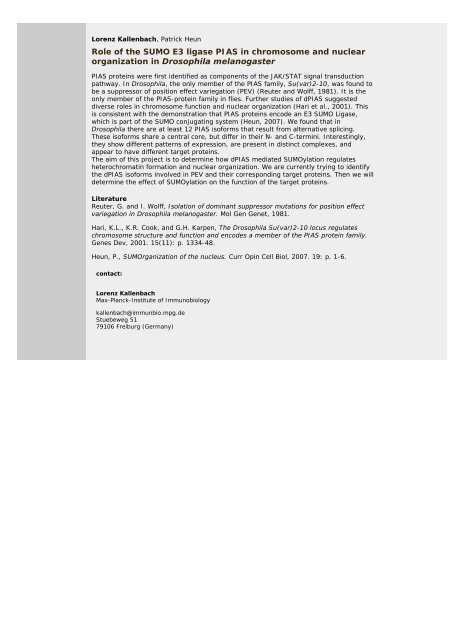Abstracts (poster) - Wissenschaft Online
Abstracts (poster) - Wissenschaft Online
Abstracts (poster) - Wissenschaft Online
Create successful ePaper yourself
Turn your PDF publications into a flip-book with our unique Google optimized e-Paper software.
Lorenz Kallenbach, Patrick Heun<br />
Role of the SUMO E3 ligase PIAS in chromosome and nuclear<br />
organization in Drosophila melanogaster<br />
PIAS proteins were first identified as components of the JAK/STAT signal transduction<br />
pathway. In Drosophila, the only member of the PIAS family, Su(var)2-10, was found to<br />
be a suppressor of position effect variegation (PEV) (Reuter and Wolff, 1981). It is the<br />
only member of the PIAS-protein family in flies. Further studies of dPIAS suggested<br />
diverse roles in chromosome function and nuclear organization (Hari et al., 2001). This<br />
is consistent with the demonstration that PIAS proteins encode an E3 SUMO Ligase,<br />
which is part of the SUMO conjugating system (Heun, 2007). We found that in<br />
Drosophila there are at least 12 PIAS isoforms that result from alternative splicing.<br />
These isoforms share a central core, but differ in their N- and C-termini. Interestingly,<br />
they show different patterns of expression, are present in distinct complexes, and<br />
appear to have different target proteins.<br />
The aim of this project is to determine how dPIAS mediated SUMOylation regulates<br />
heterochromatin formation and nuclear organization. We are currently trying to identify<br />
the dPIAS isoforms involved in PEV and their corresponding target proteins. Then we will<br />
determine the effect of SUMOylation on the function of the target proteins.<br />
Literature<br />
Reuter, G. and I. Wolff, Isolation of dominant suppressor mutations for position effect<br />
variegation in Drosophila melanogaster. Mol Gen Genet, 1981.<br />
Hari, K.L., K.R. Cook, and G.H. Karpen, The Drosophila Su(var)2-10 locus regulates<br />
chromosome structure and function and encodes a member of the PIAS protein family.<br />
Genes Dev, 2001. 15(11): p. 1334-48.<br />
Heun, P., SUMOrganization of the nucleus. Curr Opin Cell Biol, 2007. 19: p. 1-6.<br />
contact:<br />
Lorenz Kallenbach<br />
Max-Planck-Institute of Immunobiology<br />
kallenbach@immunbio.mpg.de<br />
Stuebeweg 51<br />
79106 Freiburg (Germany)

















